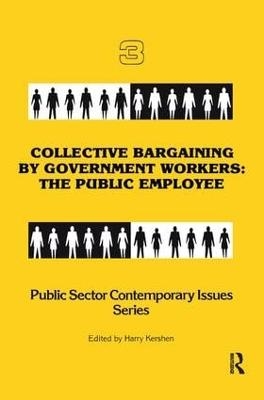
Collective Bargaining by Government Workers
Routledge (Verlag)
978-0-415-78561-7 (ISBN)
The chapters in this anthology deal with many of these all-encompassing constraints and how the various participants seek to deal with them. Model agreements, negotiating levers, the balance of power between managers and government employees, contracting-out versus producing in-house, the impact of bargaining unit structure on productivity, the relationship of municipal budget making to collective bargaining, public employee union growth and organizing trends, and many other topics are dealt with in this volume. These issues are discussed in the context of several specific types of public employees such as: municipal protection employees, mass transit workers, health professionals in relation to government service, and, the armed forces and civilian federal employees.
Harry Kershen
Preface
PART I MUNICIPAL PROTECTION EMPLOYEES: ORGANIZATIONS, NEGOTIATIONSAND IMPLICATIONS
A Typology of Police Collective Bargaining Employee Organizations, Charles R. Swanson, Jr.Police Supervisor Collective Bargaining Representation and Identification with Management, Kent F. MurrmannSignificant Management Rights Clauses in Municipal Police Contracts, Craig E. Overton and Max S. Wortman, Jr.Pay Parity Between Police and Fire Fighters, James C. AmarImpasse Resolution Preferences of Fire Fighters and Municipal Negotiators, Hoyt N. Wheeler and Frank Owen
PART II COLLECTIVE BARGAINING IN THE MASS TRANSIT INDUSTRY
Local Labor Negotiations and the Urban Mass Transit Industry, Alan ReedBudgetary Influences on Bargaining in Mass Transit, Kenneth M. Jennings, Jay A. Smith, Jr., and Earle C. Traynham, Jr.
PART III NEGOTIATIONS AND HEALTH
Health Insurance in the Public Sector, Richard S. RubinContemporary Perceptions of Unionization in the Medical Profession: A Study of Attitudes of Unionized and Non-Union Physicians, Jon A. Klover, David B. Stephens, and Vincent P. Luchsinger
PART IV UNIONIZATION IN THE ARMED FORCES
An Assessment of Unionization in the Armed Forces, Paul D. StaudoharOrientations toward Military Unions among Combat Troops, David R. Segal and Robert C. KramerThe Rejection of Military Unionization: Analysis of the AFGE Data, Jerald F. Robinson and James K. McCollum
PART V EMPLOYEE RELATIONS IN THE FEDERAL SERVICE
National Treasury Employees Union: Description of a Federal Employee Union, M.J. Fox, Jr. and Marvin JudahProductivity Improvement in Government: The Effects of Departmental vs. Occupational Bargaining Unit structures, Michael L. MooreThe Impact of Grievance and Arbitration Processes on Federal Personnel Policies and Practices: The View from Twenty Bargaining Units, George T. Sulzner
PART VI ISSUES THAT TRANSCEND OCCUPATIONAL LINES
The Ability to Pay Criterion: Some Recent Evidence, Charles T. WeberSubcontracting in State and Local Government Employment, Paul D. StaudoharEmployees Who Refuse to Pay Union Dues: First and Fourteenth Amendment Issues in Nonassociation Union Security Agreements, G.W. CassidyTraining Programs for Neutrals, Ralph S. BergerStudies in Mediation and the Training of Public Sector Mediators, David C. Haman, Arthur P. Brief, and Richard Pegnetter
| Erscheinungsdatum | 11.02.2017 |
|---|---|
| Reihe/Serie | Public Sector Contemporary Issues |
| Verlagsort | London |
| Sprache | englisch |
| Maße | 152 x 229 mm |
| Gewicht | 1100 g |
| Themenwelt | Medizin / Pharmazie ► Medizinische Fachgebiete ► Notfallmedizin |
| Sozialwissenschaften ► Politik / Verwaltung ► Staat / Verwaltung | |
| Wirtschaft | |
| ISBN-10 | 0-415-78561-8 / 0415785618 |
| ISBN-13 | 978-0-415-78561-7 / 9780415785617 |
| Zustand | Neuware |
| Informationen gemäß Produktsicherheitsverordnung (GPSR) | |
| Haben Sie eine Frage zum Produkt? |
aus dem Bereich


